
Japan’s Regional Festivals Mark the Seasons with Prayers and Local Color
Guideto Japan
Culture Lifestyle- English
- 日本語
- 简体字
- 繁體字
- Français
- Español
- العربية
- Русский
Seasonal Festivals Marking the Cycle of Life
Japan’s systems of faith have long been relatively tolerant of outside influence, with native animist Shintō coexisting and even melding with Buddhism. Traditions in Japan honor both the spirits existing within the natural world and those of departed ancestors. Even terrible spirits of vengeance and demonic oni have at times been revered for their strength as protective kami (deities) that stave off plague and disaster.
Traditional faith offers up prayers not only to the kami dwelling in the earth, but also to those spirits and divinities that come and go with the changing of the seasons. Diverse festivals held throughout the year help bring a seasonal cycle to life, offering up prayers for bountiful harvests or safety from disease and disaster.
Performances offered to the kami at these festivals have developed their own unique styles in different regions. Mikoshi, portable shrines carried in parades, and floats called dashi are often parts of costumed processions that entertain not only the kami but also local people.
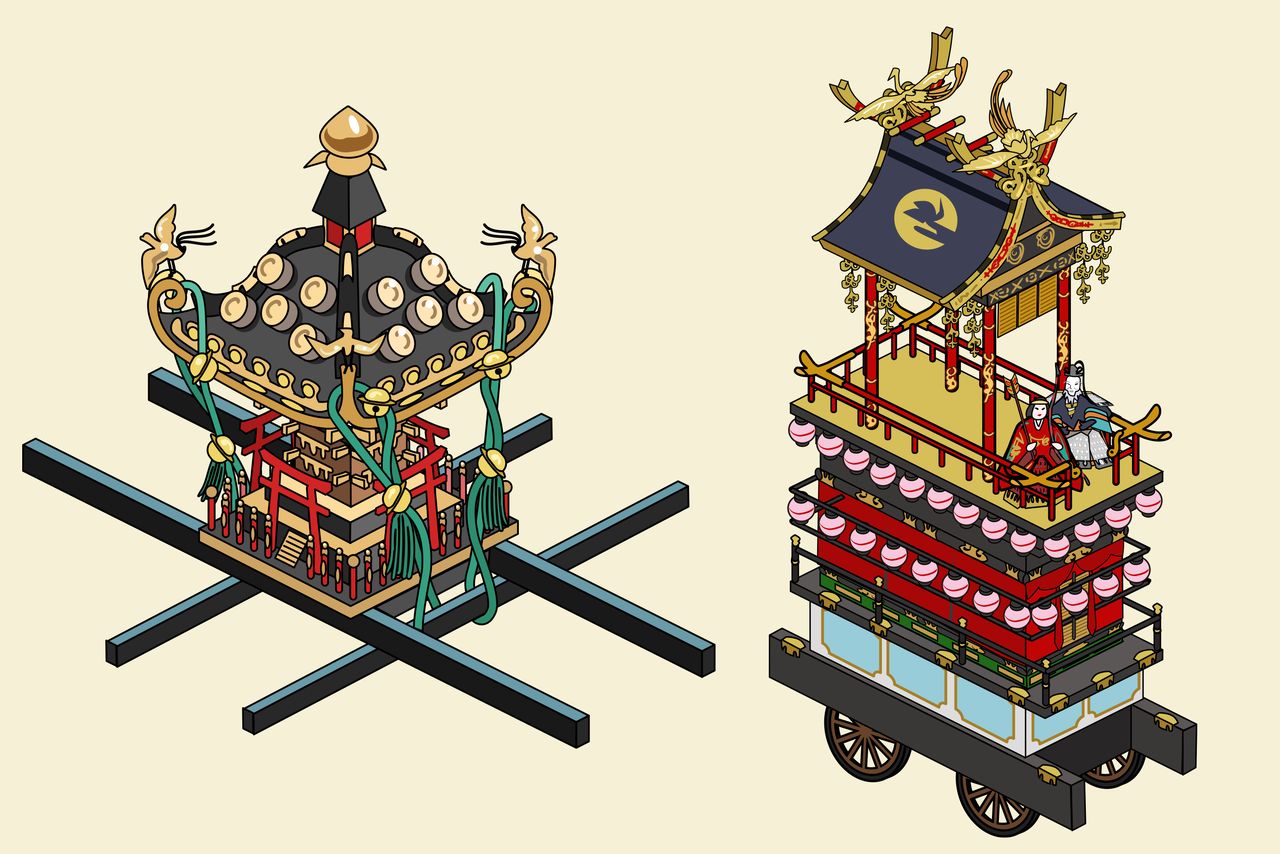
Mikoshi are considered vehicles of the kami, and the faithful of the connected shrine carry them across the earth. Many are modeled on a traditional shrine design (at left). On dashi floats, people join the kami on board to offer up performances. They take a variety of shapes and are also sometimes called hikiyama or yatai (at right). (© Pixta)
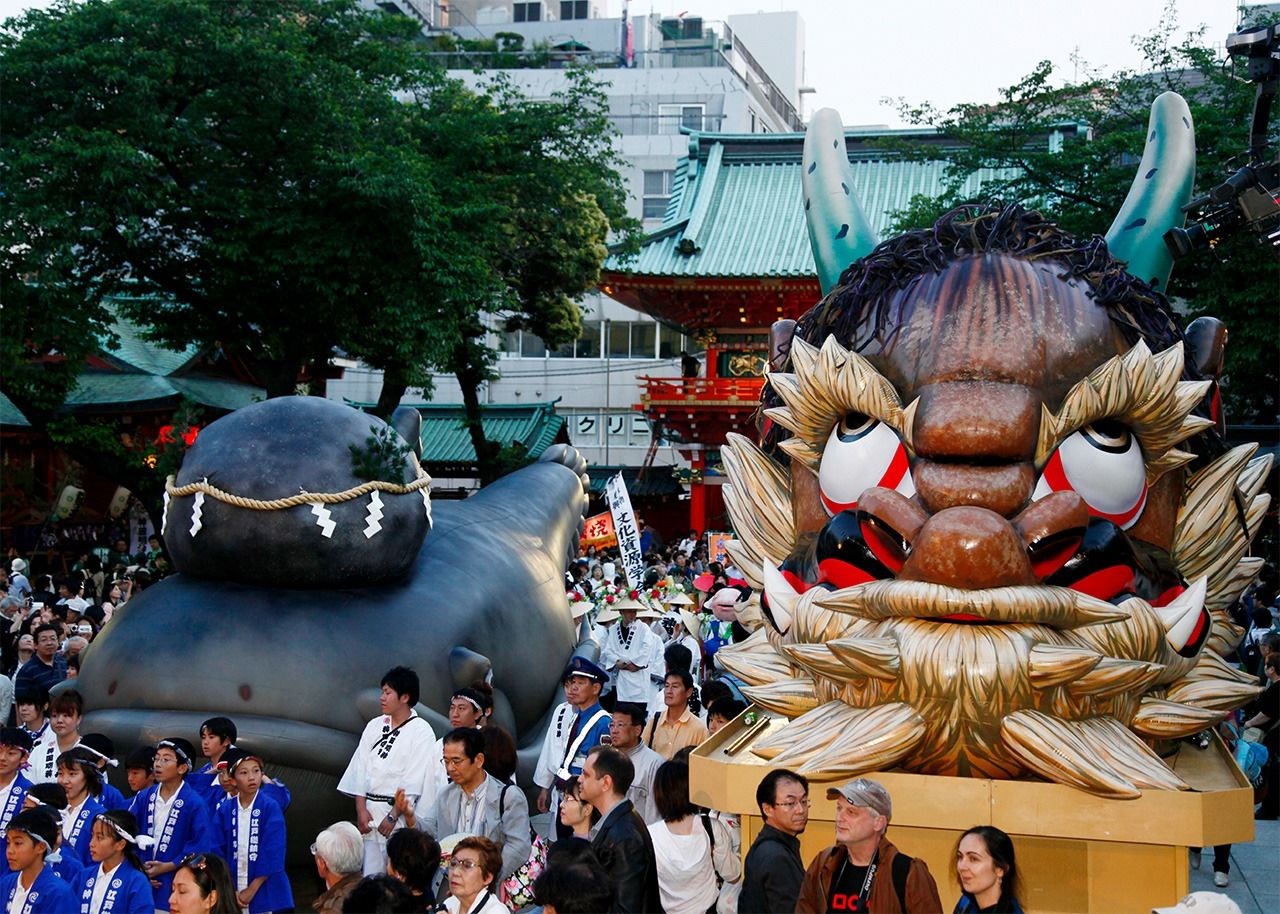
Yatai with yōkai, or mystical creatures, in the Kanda Matsuri, held in Chiyoda, Tokyo, in mid-May. Shuten Dōji (right) is a powerful oni, and the namazu catfish (left) is said to cause earthquakes. A sacred kanameishi stone holds it still.
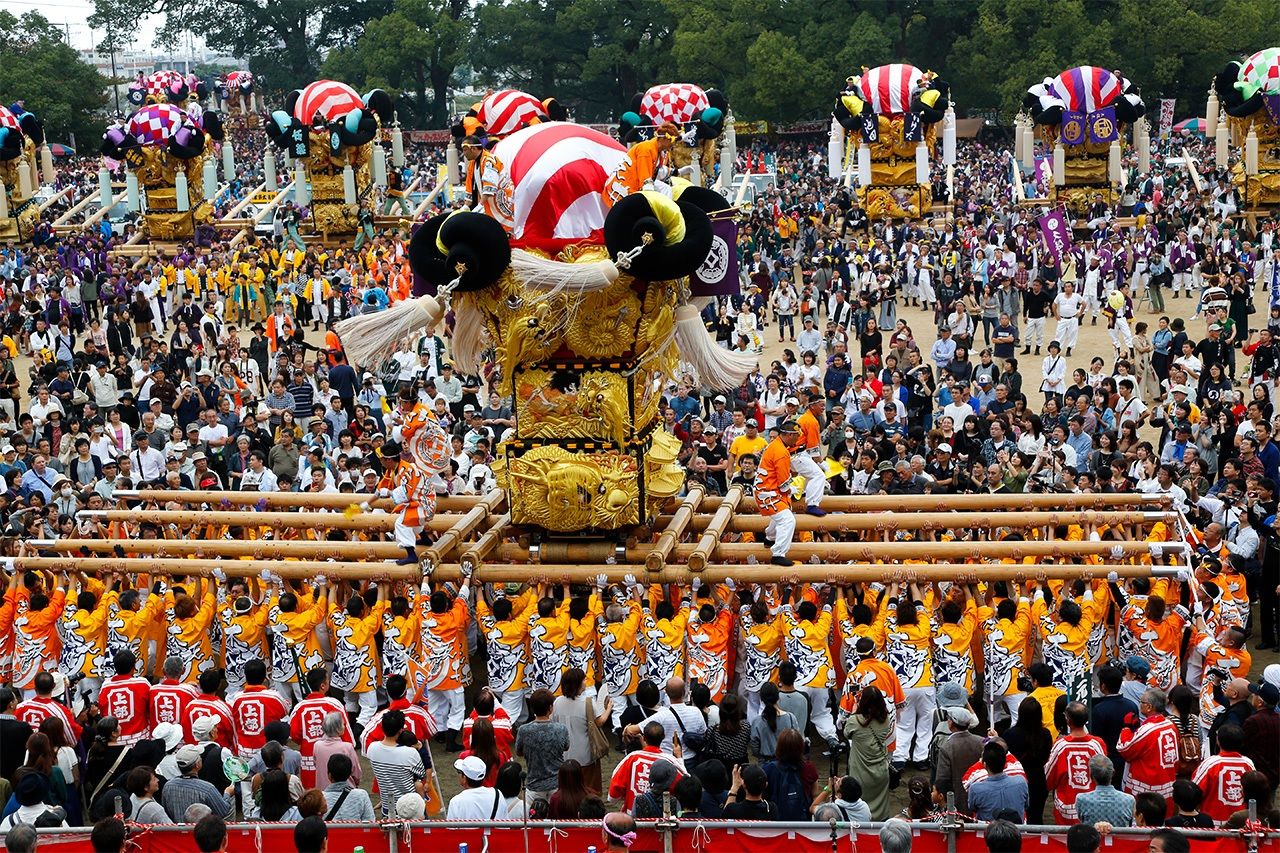
The Niihama Taikomatsuri—held in Niihama, Aichi Prefecture, from October 16 to 18—features floats called taikodai with elaborate canopies embroidered with male and female dragons.
Koshōgatsu: The “Little New Year” Prayer for Harvest Bounty
After the send-off for the toshigami (New Year gods), Koshōgatsu—usually around January 15, but sometimes based on the old lunar calendar—is a time for rites to pray for bountiful grain harvests in the upcoming year. In the Tōhoku region, these prayers take the shape of Secchūtaue, “planting” rice or grain bundles in snowfields as if they were rice paddies. In Tokyo, there is a famous ceremony at Itabashi’s Tokumaru Kitano Shrine called Taasobi, where stages with taiko drums are erected in rice fields to celebrate the planting.
In Aomori Prefecture, the northernmost part of Honshū, they perform a dance called the enburi, where farmers stab pole-like farming implements called eburi into the frozen soil to release demons trapped in the earth and usher in the spring. There is a similar festival in far-off Kagoshima Prefecture, in the south of Kyūshū. The Harameuchi ceremony, where children sing and beat the ground with sticks, is a ritual praying both for bountiful harvests and fertility for newlywed couples.
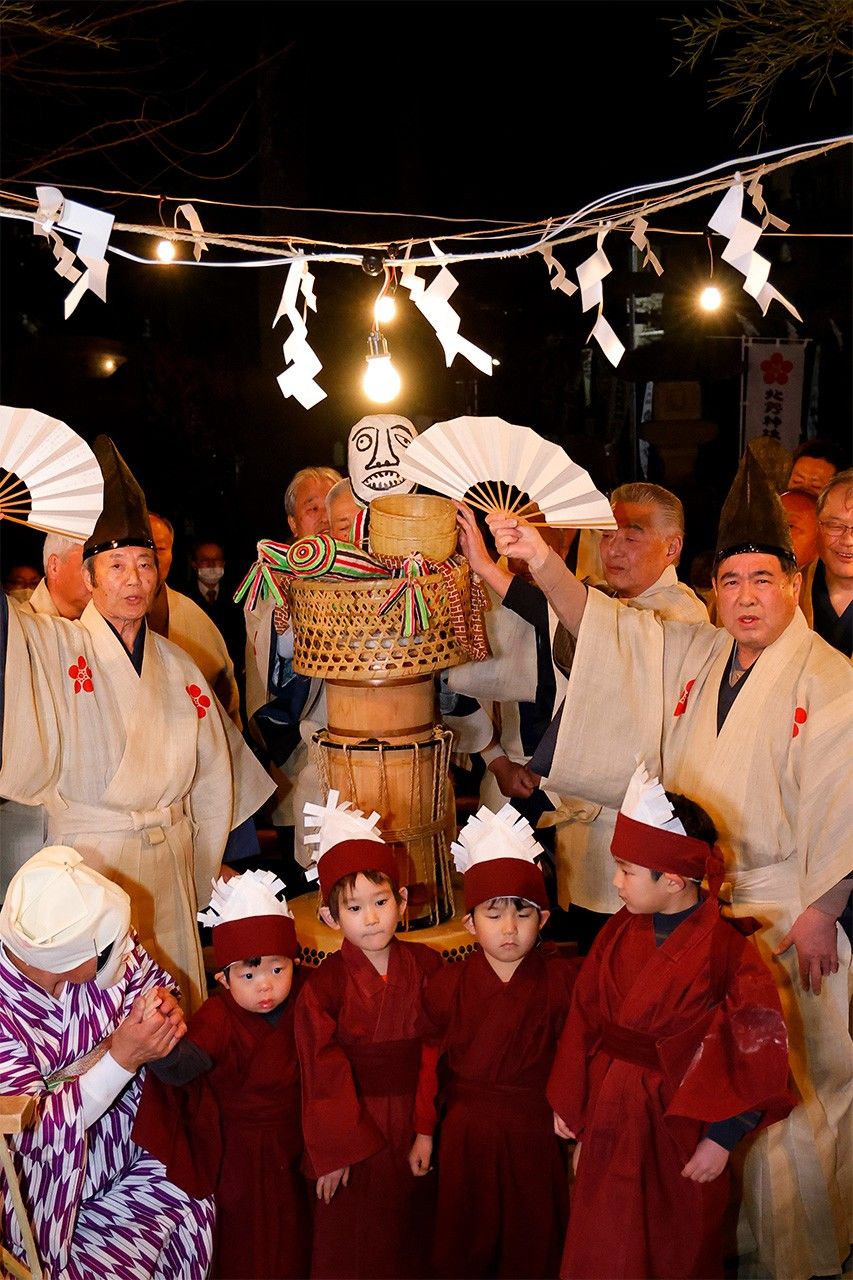
The Tokumaru Kitano Shrine Taasobi, which prays for healthy growth for both rice and children. Held every February 11, in Itabashi, Tokyo.
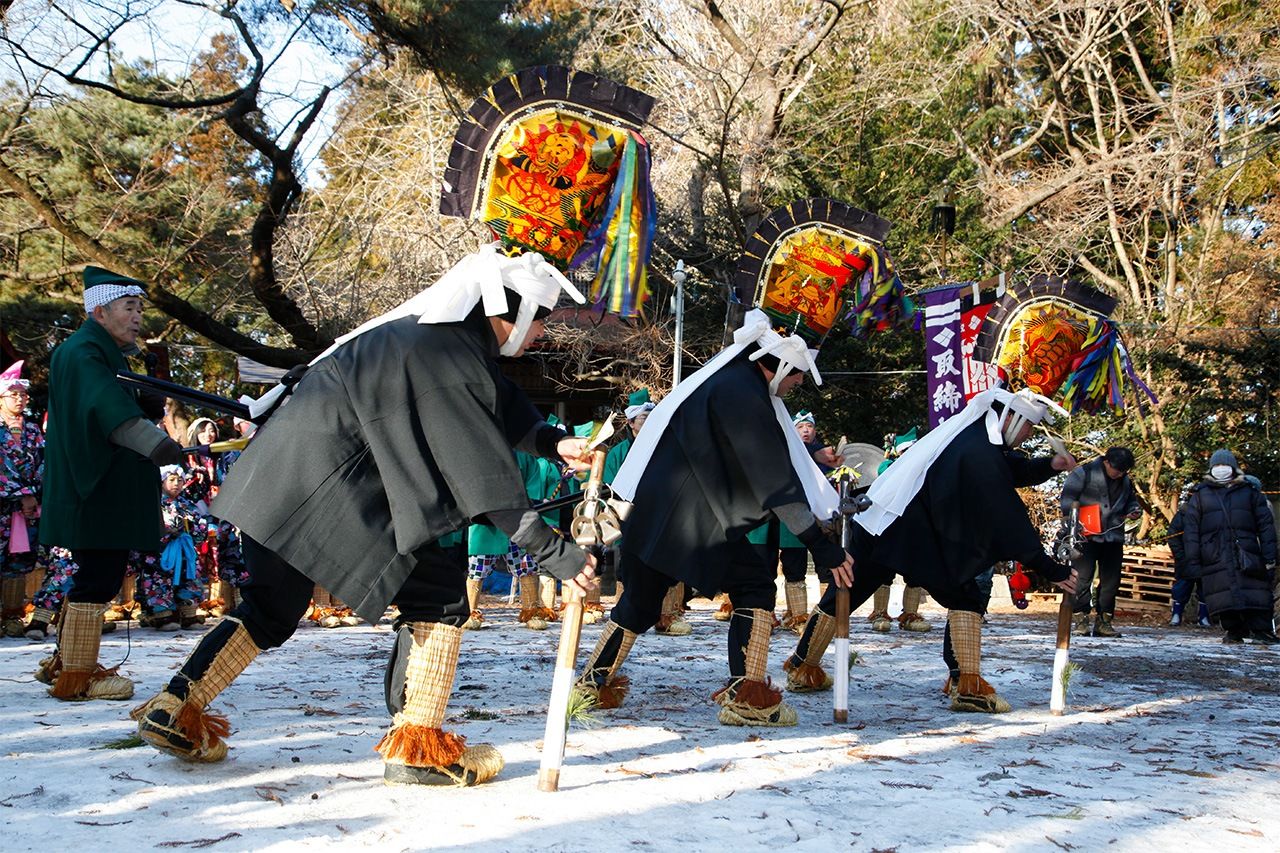
Hachinohe enburi, a dance carrying prayers for field fertility. Held annually February 17–20 in Hachinohe, Aomori Prefecture.
Driving out the Oni on Setsubun
The original meaning of Setsubun was the changing of each season, but now it is generally used to refer to the day before Risshun, when spring arrives on the traditional calendar—most years, it is February 3. This change is likely due to the influence of the famous mamemaki, or bean throwing, ritual.
Traditionally, it was believed that evil spirits of plague and disaster appeared more easily at the change of the seasons, as oni from the spirit world got lost on their wandering. The mamemaki ritual practiced nationwide at the spring Setsubun, where children drive the oni out by throwing beans at their gaping eyes, is a prayer for good health and safety.
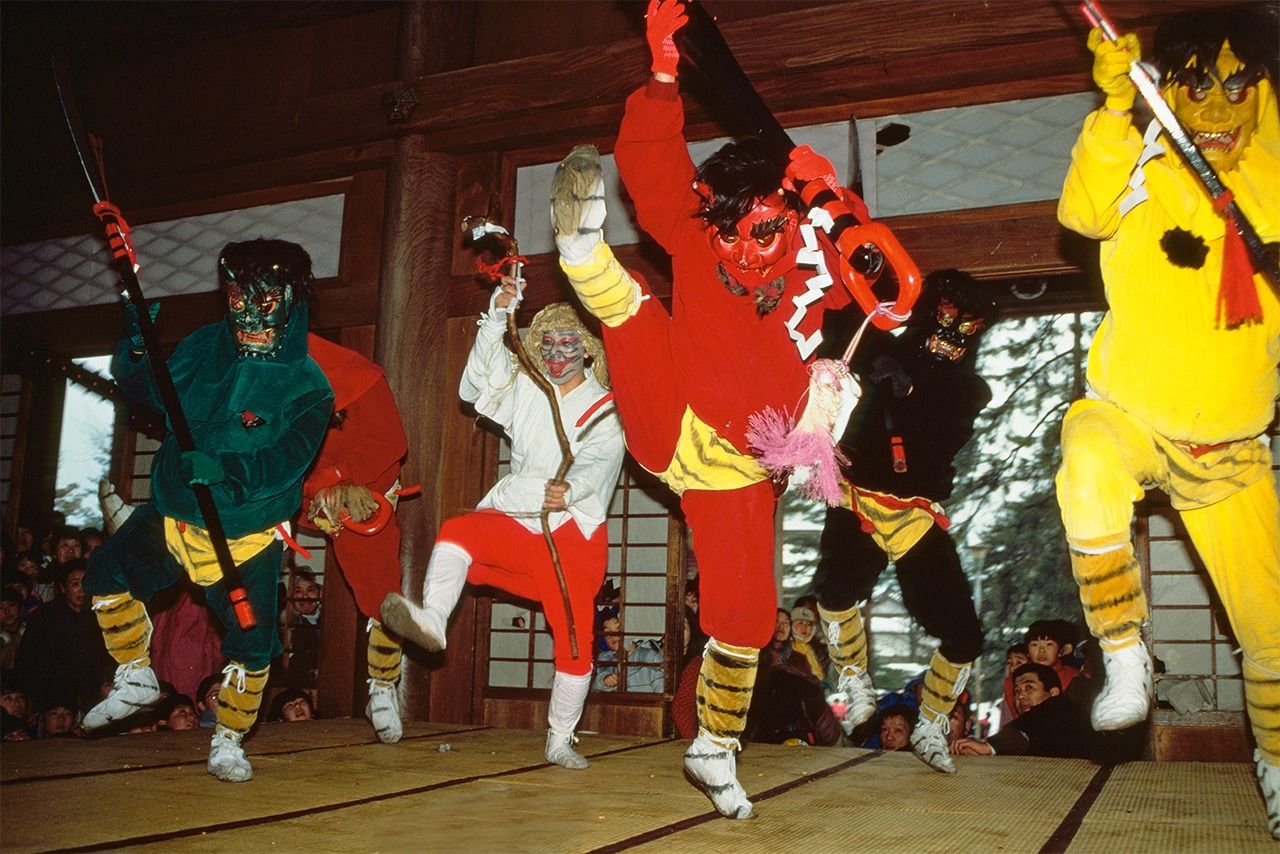
Colorful oni run wild as onlookers throw beans to drive them away in the Honjōji Oniodori ritual held in Sanjō, Niigata Prefecture, every February 3.
Springtime Prayers for Bounty
When the flowers are blooming and the tsuyu rainy season approaches, Taue festivals mark the rice planting season. Many include wearing vibrantly colored flower decorations in a tradition believed to go back over 2,000 years. This is because the flowering of spring is a promise of bountiful autumn harvests. At Ōi Hachimangū Shrine in Yaizu, Shizuoka Prefecture, the Fujimori no Taasobi festival is held in which young participants wear flowered crowns over one meter tall as they dance and pray, singing hanayo, saki, hirake (O flowers, bloom and open).
In the past, farming was work built on community connections as a village banded together, and agricultural festivals are the same. The whole community works together, singing rice planting songs and giving thanks to the kami of the fields. Saotome, young women planting rice in water-filled paddies, are an iconic image of Japan’s countryside.
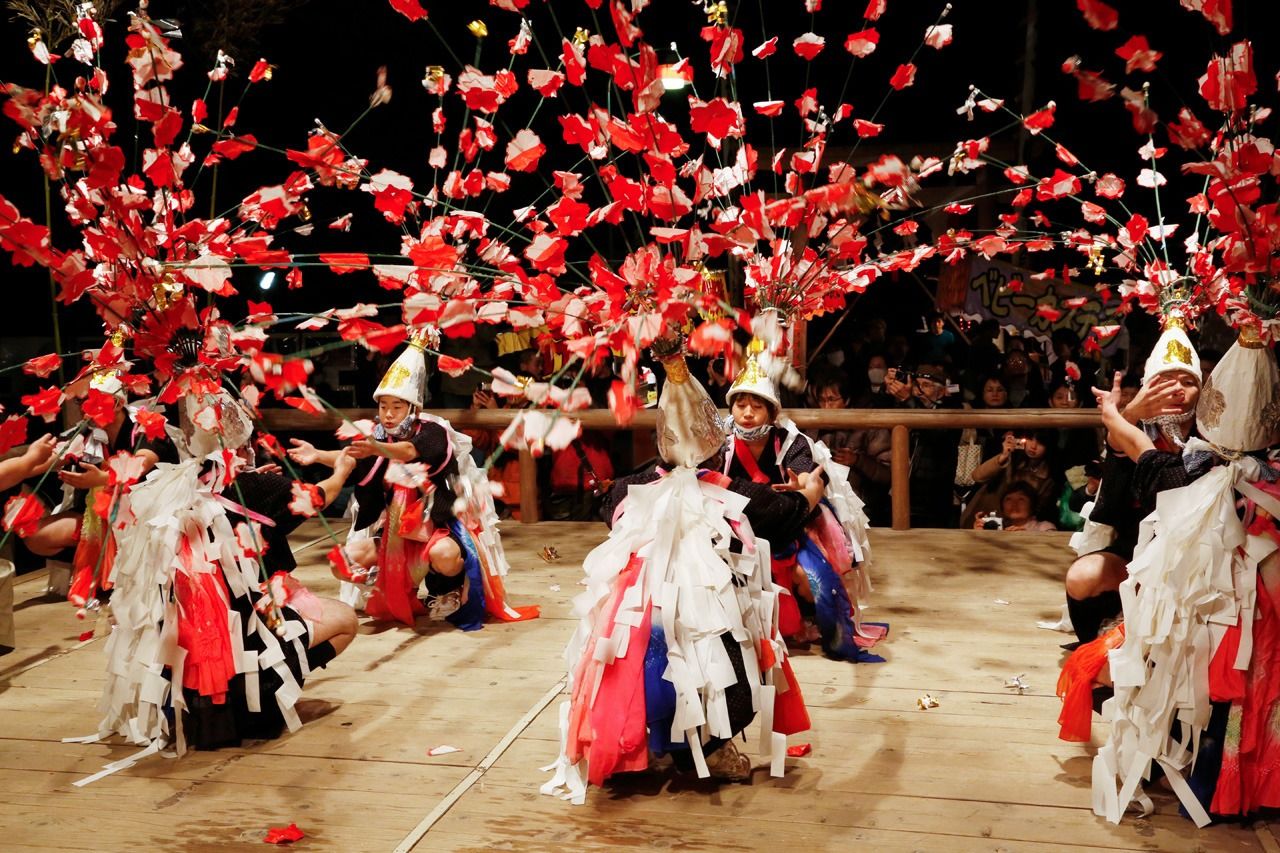
The Fujimori no Taasobi festival represents the yearly farming cycle on stage. Held in Yaizu, Shizuoka Prefecture, every March 17.
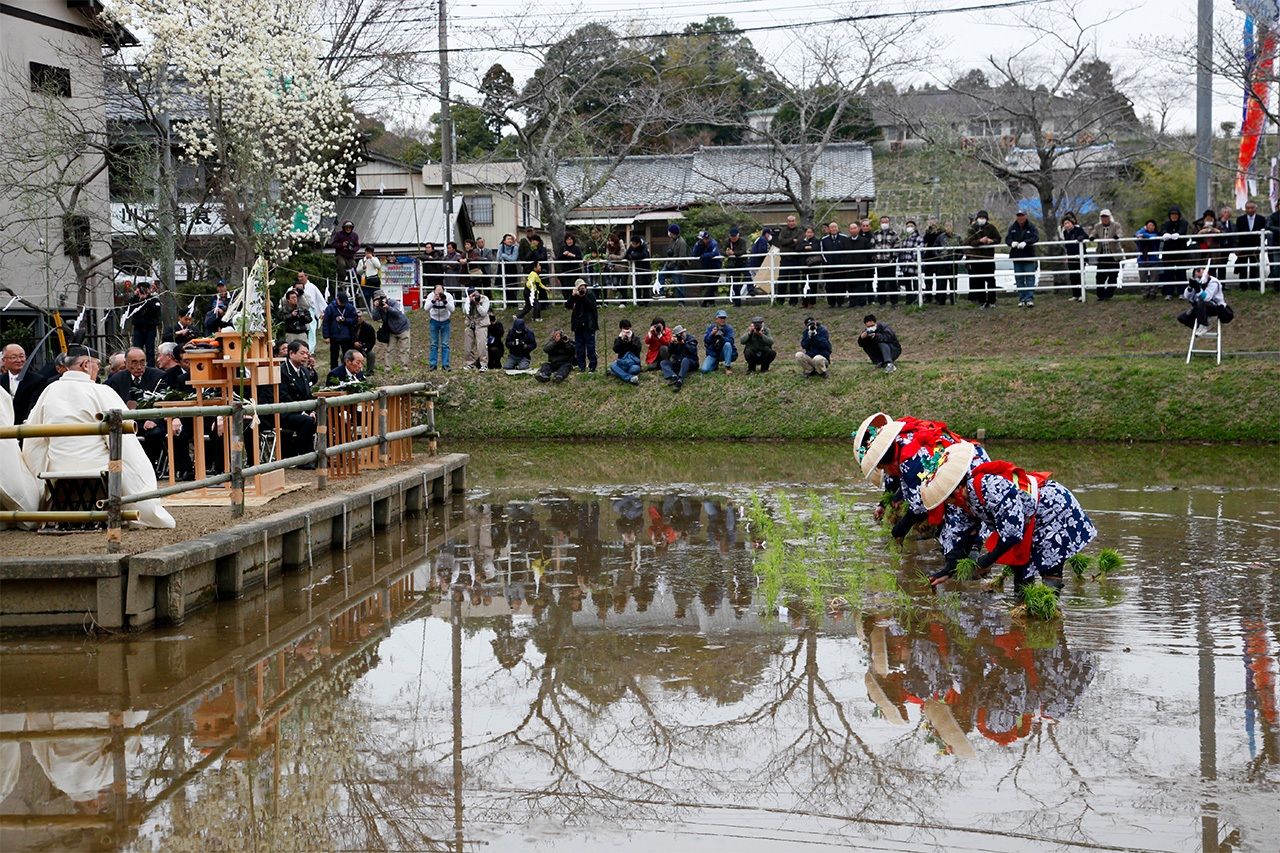
Saotome sing rice planting songs as they transplant rice seedlings into a shrine’s sacred paddy in the Katorijingū Otauesai in Katori, Chiba Prefecture. Held every year April 1–2.
Protecting Fields from Pests in Rainy Season
With the coming of tsuyu in late May or early June, farmers perform mushiokuri rituals to drive off pests. In eastern Japan, people make large insects out of straw to draw bugs to the paths between fields and then burn them out or wash them away in rivers or the sea.
In western Japan, this ritual is connected to a story about Saitō Sanemori, a general of the Heike clan. During the Genpei War (1180-1185), Sanemori was killed when his horse tripped on some straw. His dying words were, “I will become a pest and haunt these rice fields.” Now, farmers create a Sanemori doll mounted on a horse of straw and parade it through the rice fields, driving away both the spirit and insects.
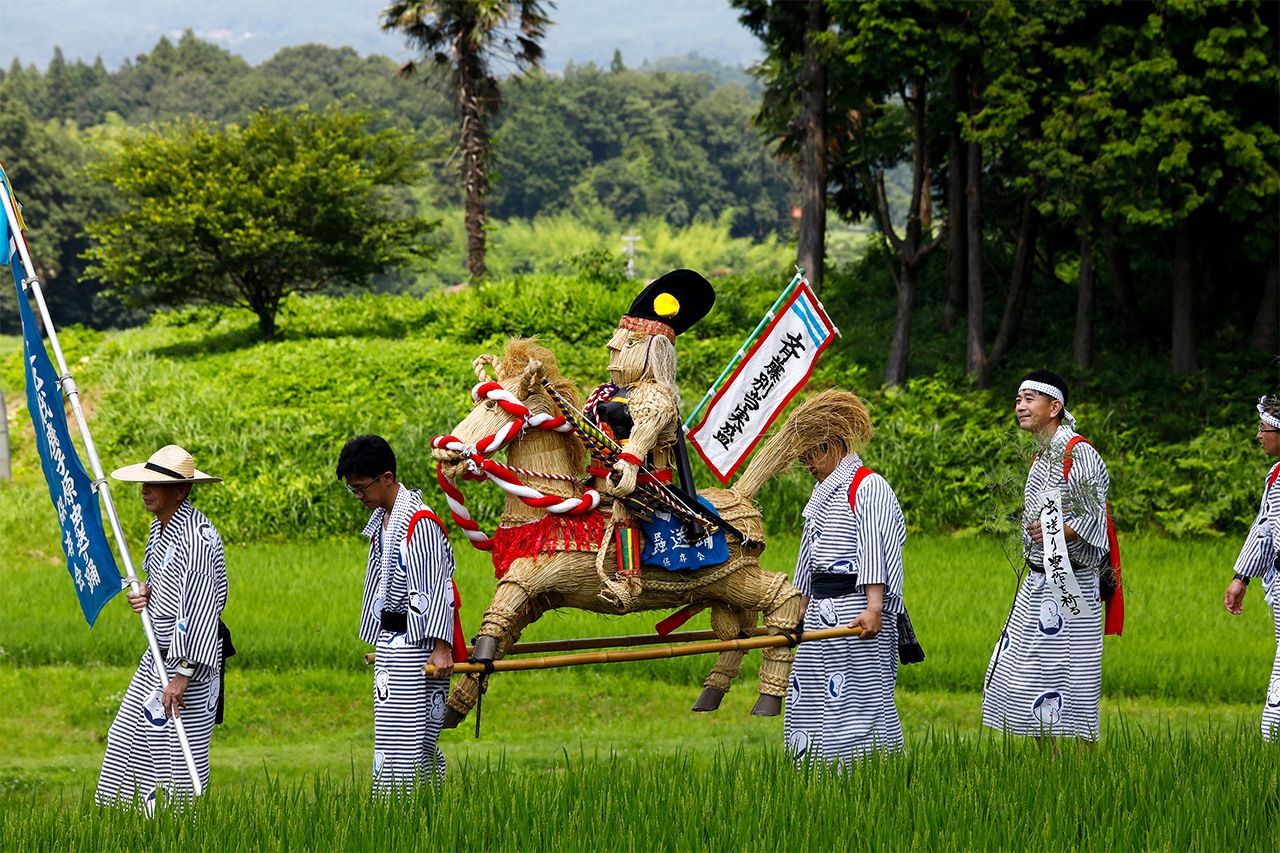
A Sanemori doll for the Kanekobara no Mushiokuri Odori ritual in Ōnan, Shimane Prefecture, on July 20.
Driving off Spirits that Bring Disease in Summer
Bacteria thrive in Japan’s hot and humid summer, and in the past, illness was common. People of the time thought that the spirits of the dead were the cause, and Japan is filled with energetic festivals intended to drive them away.
The oldest example is Kyoto’s Gion Festival, which started in the ninth century when plague took many lives. At first, courtiers would erect 66 decorated spears—one for each of Japan’s regions at the time—and a mikoshi for the plague kami Gozu Tennō was taken on a pilgrimage out of Gion Shrine (now Yasaka Shrine) to pray for the safety of all Japan. As time passed, the spears evolved into lavish floats called yamahoko, and this is now the country’s most elegant festival.
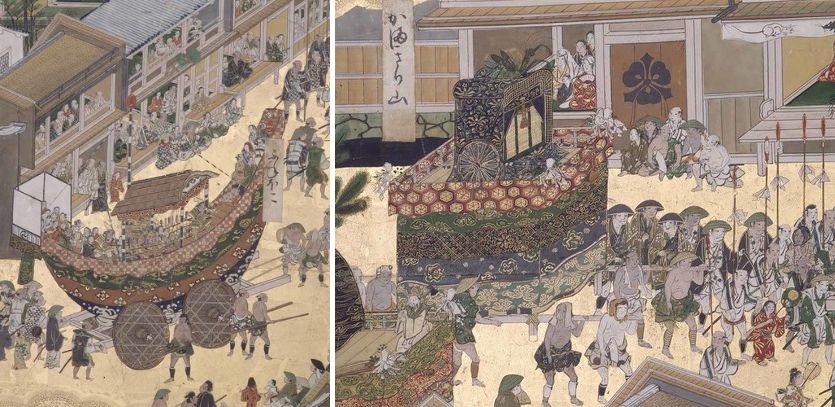
Images of yamahoko floats from the seventeenth century decorated much the same as modern ones. Taken from the Gionseireizu byōbu (Scenes of the Gion Festival). (Courtesy Kyoto National Museum)

A hanging altar scroll dedicated to Gozu Tennō.
Summertime fireworks festivals started with the aim of staving off disaster. Japan’s oldest fireworks show, Tokyo’s Sumidagawa Fireworks Festival, started in the Kyōhō era (1716–36), another time of great plague. People set off fireworks along the Sumida River at Ryōgoku to calm the spirits and drive off disease.
In Tōhoku summer festivals, it seems that people are eager to let out all the energy stored up over the long northern winter. Festivals like the Aomori Nebuta Matsuri and Yamagata Hanagasa Matsuri, known for brilliant dances and parades, bring visitors from all over Japan.

Leisure boats for viewing the thrilling Sumidagawa Fireworks Festival in Taitō and Sumida, Tokyo, on the last Saturday in July.
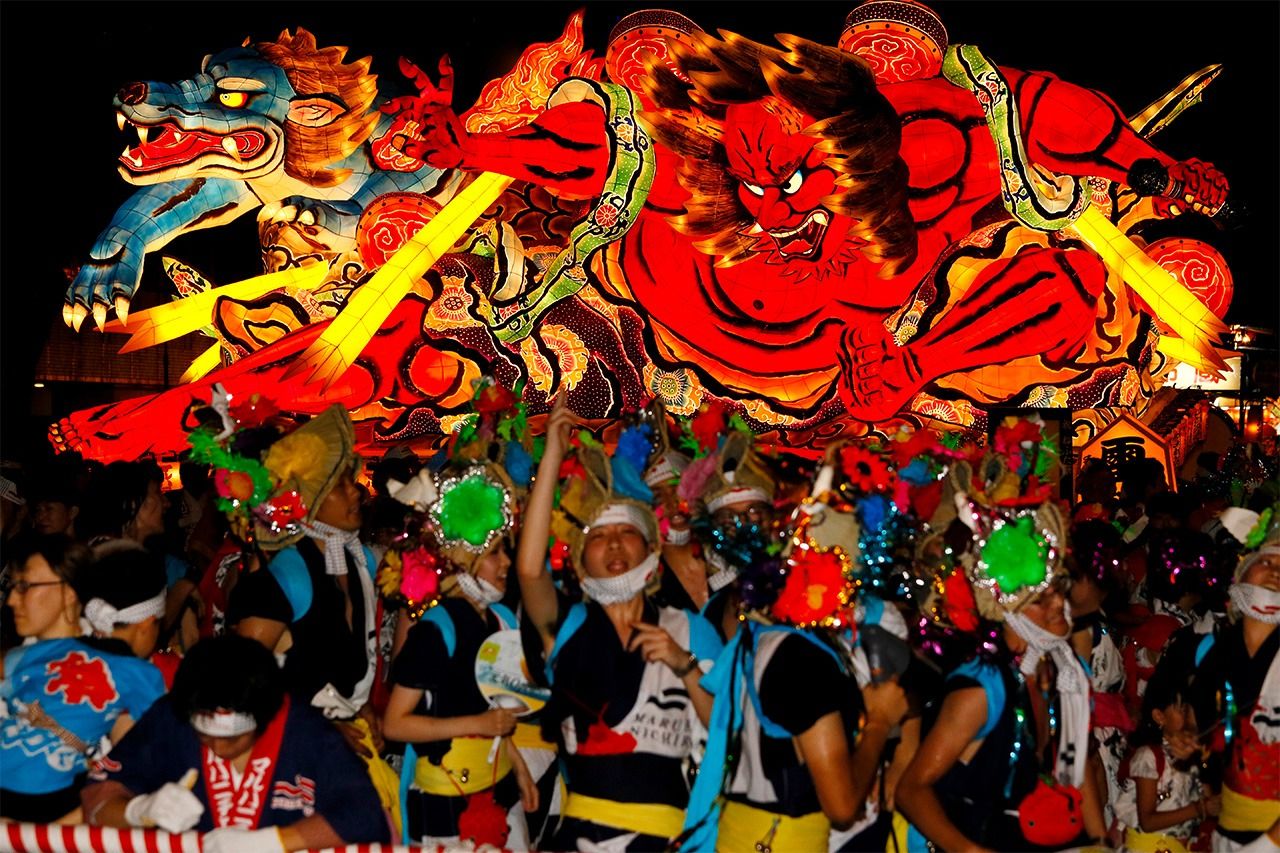
The Aomori Nebuta Matsuri features enormous lantern floats and dancers called haneto parading through the city. The origin is believed to be a lantern floating ceremony. Held in Aomori, Aomori Prefecture, August 2–7.
Offering Thanks for the Harvest
In the autumn harvest season, people offer up the first ears of rice in gratitude for the harvest and in prayer for the next year’s bounty. The Niinamesai is a court ritual related to the harvest that is so old it appears in the Nihon shoki, a record of ancient Japan completed in 720.
Mikoshi and floats bearing kami are paraded around rice fields before or during the harvest, to display the full heads of rice and sheaves of harvest rice drying in the sun. In Saitama Prefecture’s Kawagoe Matsuri, 29 gorgeously decorated floats are drawn through the streets of historic Kawagoe, known as “Little Edo.” Summer truly is Japan’s liveliest season for festivals.
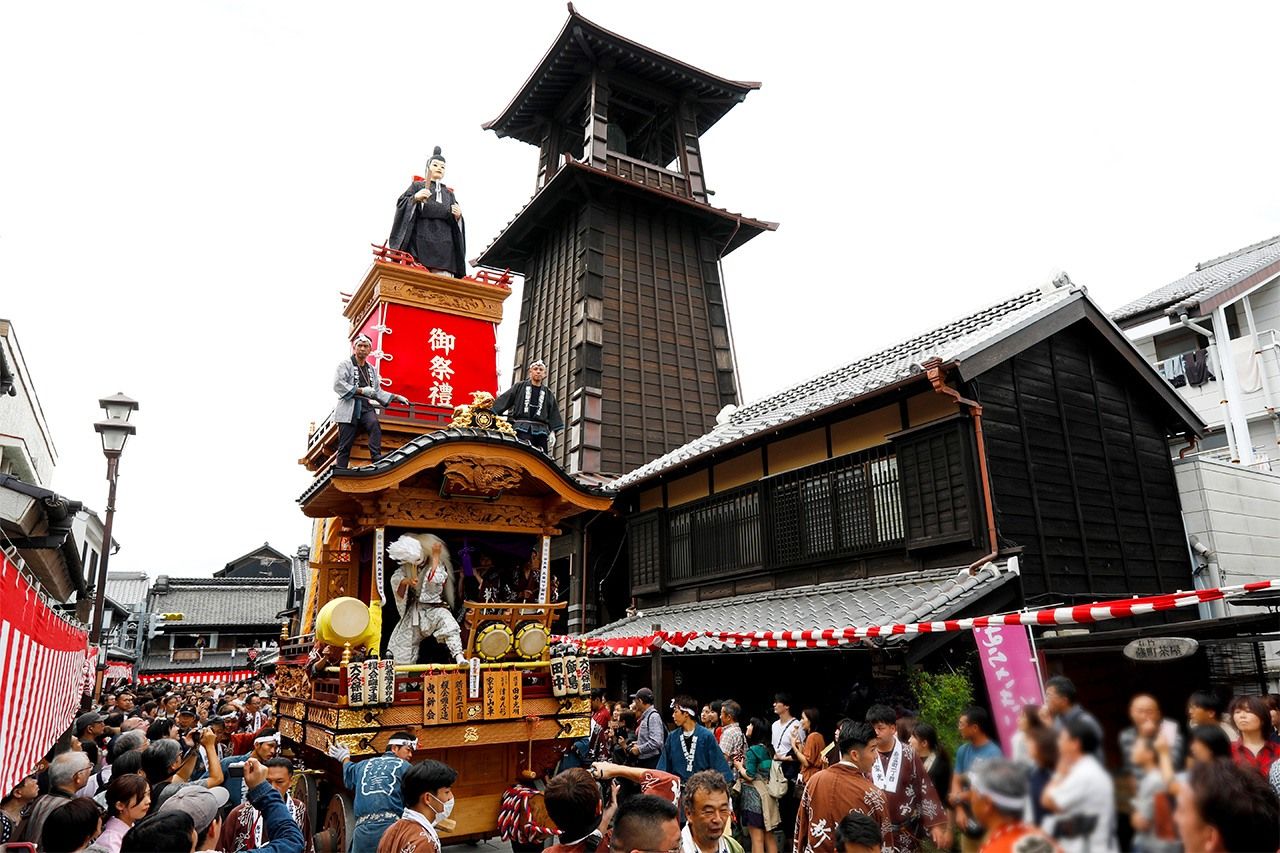
Hikawa Shrine’s annual festival, the Kawagoe Matsuri. Each district has its own floats with images of kami and people on board, playing music and dancing. Held in Kawagoe, Saitama Prefecture, on the third Saturday and Sunday in October.
Reviving the Spirit in Winter
In winter, villagers perform yokagura plays to send off the rice field kami as they return to the mountains. Old beliefs say that the human soul is weakest around the winter solstice, when daylight hours are shortest, so it is a time for rituals to revive the spirit.
At the Tōyama no Shimotsuki Matsuri in Iida, Nagano Prefecture, or the Hanamatsuri in the northern Aichi Prefecture region of Okumikawa, they perform a play called the Yudatekagura, where visitors are sprinkled with water boiled in a pot as a symbol of the breath of the kami. It is believed this will strengthen the spirit and allow for a safe new year.
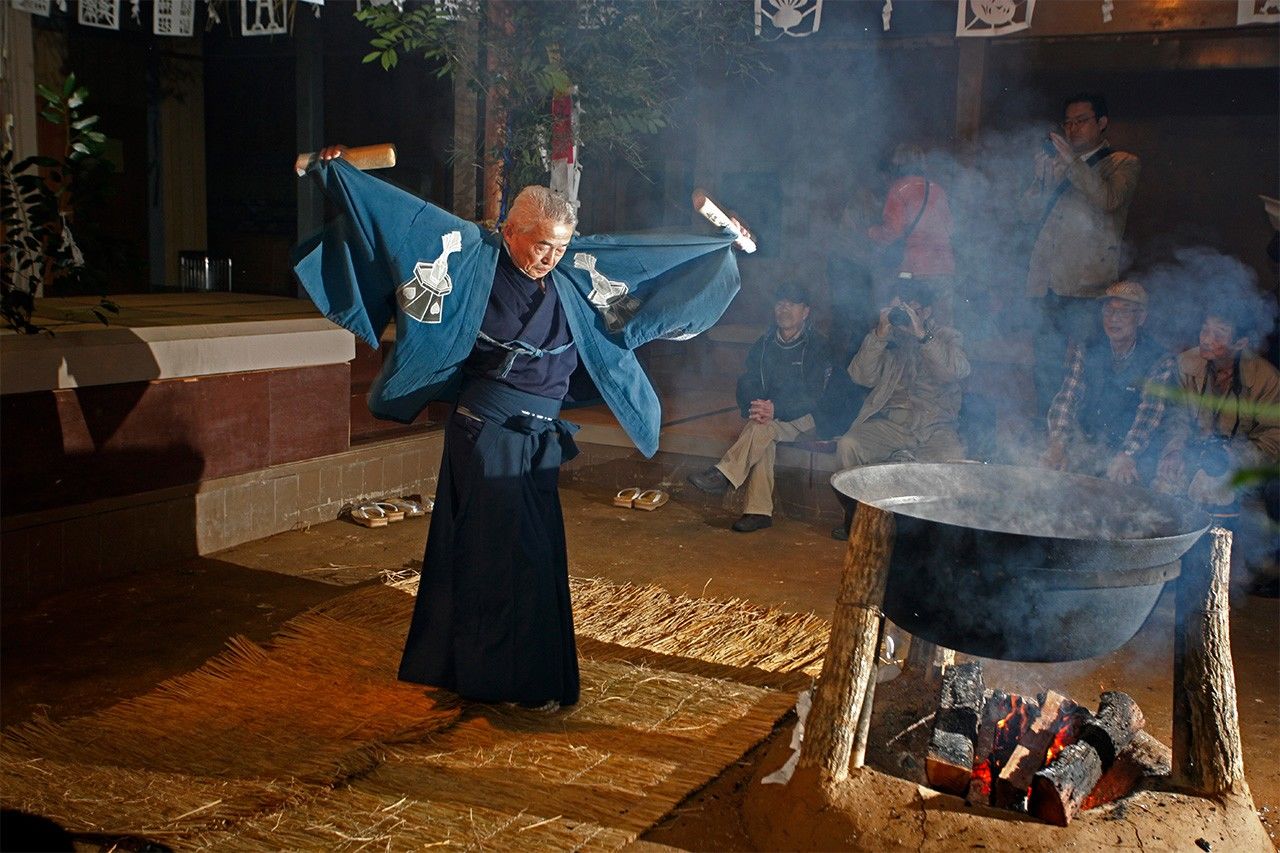
The Hanamatsuri of Okumikawa features an evening dance that has been passed down over the years in Kitashitara County, Aichi Prefecture. The performance period lasts from November to January.
*Dates given for festivals are the days they take place on in a typical year.
(Originally published in Japanese. Banner photo: Hie Shrine’s Sannō Matsuri festival, also known as the Spring Takayama Festival, in Takayama, Gifu Prefecture, on April 14–15. Parade members pull 12 lacquered three-tiered floats, three of which are dedicated to karakuri puppet performance. Photos © Haga Library unless otherwise noted.)